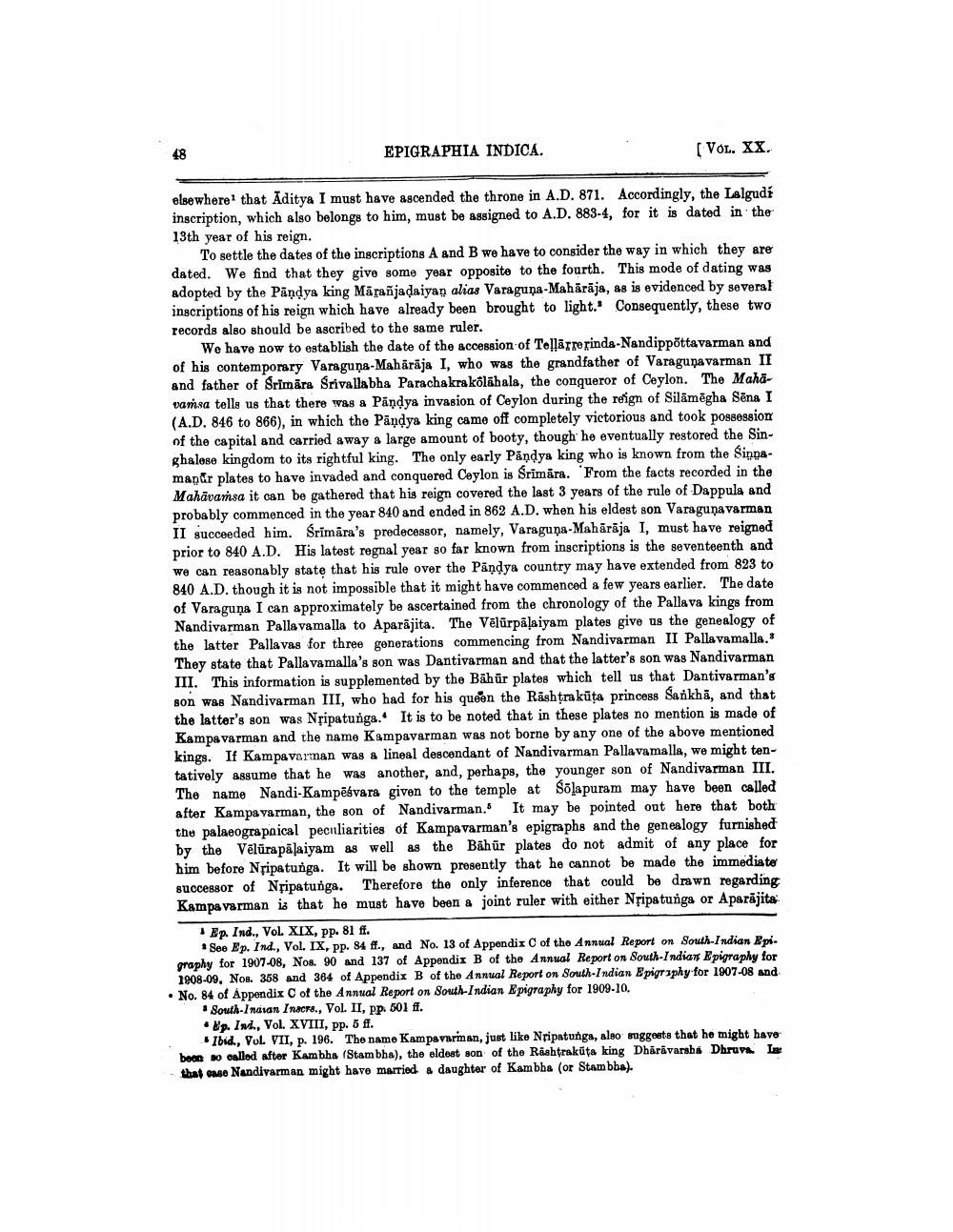________________
EPIGRAPHIA INDICA.
(VOL. XX.
elsewhere that Aditya I must have ascended the throne in A.D. 871. Accordingly, the Lalgudi inscription, which also belongs to him, must be assigned to A.D. 883-4, for it is dated in the 13th year of his reign.
To settle the dates of the inscriptions A and B we have to consider the way in which they are dated. We find that they give some year opposite to the fourth. This mode of dating was adopted by the Pandya king Mäpañjadaiyan alias Varaguņa-Mahārāja, as is evidenced by several inscriptions of his reign which have already been brought to light. Consequently, these two records also should be ascribed to the same ruler.
We have now to establish the date of the accession of Tellarterinda-Nandippóttavarman and of his contemporary Varaguna-Mahārāja I, who was the grandfather of Varagunavarman II and father of Srimāra Srivallabha Parachakra kõlāhala, the conqueror of Ceylon. The Mahavamsa tells us that there was a Pandya invasion of Ceylon during the reign of Silāmēgha Sēna I (A.D. 846 to 866), in which the Pandya king came off completely victorious and took possession of the capital and carried away a large amount of booty, though he eventually restored the Singhalese kingdom to its rightful king. The only early Pandya king who is known from the Singamantr plates to have invaded and conquered Ceylon is Srimāra. From the facts recorded in the Mahāvarsa it can be gathered that his reign covered the last 3 years of the rule of Dappula and probably commenced in the year 840 and ended in 862 A.D. when his eldest son Varagunavarman II succeeded him. Srimāra's predecessor, namely, Varaguņa-Mahārāja I, must have reigned prior to 840 A.D. His latest regnal year go far known from inscriptions is the seventeenth and we can reasonably state that his rule over the Pandya country may have extended from 823 to 840 A.D. though it is not impossible that it might have commenced a few years earlier. The date of Varaguna I can approximately be ascertained from the chronology of the Pallava kings from Nandivarman Palla vamalla to Aparājita. The Vēlürpāļaiyam plates give us the genealogy of the latter Pallavas for three generations commencing from Nandivarman II Pallavamalla. They state that Pallavamalla's son was Dantivarman and that the latter's son was Nandivarman III. This information is supplemented by the Bāhūr plates which tell us that Dantivarman's son was Nandivarman III, who had for his queen the Rashtrakūta princess Sankhā, and that the latter's son was Nțipatunga. It is to be noted that in these plates no mention is made of Kampavarman and the name Kampavarman was not borne by any one of the above mentioned kings. If Kampavorman was a lineal descendant of Nandivarman Pallavamalla, we might tentatively assume that he was another, and, perhaps, the younger son of Nandivarman III. The name Nandi-Kampēšvara given to the temple at Solapuram may have been called after Kampa varman, the son of Nandivarman. It may be pointed out here that both the palaeograpnical peculiarities of Kampavarman's epigraphs and the genealogy furnished by the Vēlūra pālaiyam as well as the Bāhūr plates do not admit of any place for him before Nripatunga. It will be shown presently that he cannot be made the immediate successor of Nripatunga. Therefore the only inference that could be drawn regarding Kampa varman is that he must have been a joint ruler with either Npipatunga or Aparajita
Bp. Ind., VOL. XIX, PP. 81 ff.
* See Ep. Ind., Vol. IX, pp. 84 ff., and No. 13 of Appendix C of the Annual Report on South Indian Epic graphy for 1907-08, Nos. 90 and 137 of Appendix B of the Annual Report on South Indian Epigraphy for
1908-09, Nos. 358 and 364 of Appendix B of the Annual Report on South Indian Epigraphy for 1907-08 and • No. 84 of Appendix C of the Annual Report on South Indian Epigraphy for 1909-10.
• South-Inasan Inacts., Vol. II, pp. 501 ff. • Ep. Ind., Vol. XVIII, pp. 5 ff.
Ibid., VOL VII, p. 196. The name Kampavarman, just like Nripatunga, also suggests that he might have boon mo oallod after Kambha (Stam bha), the eldest son of the Rashtrakūta king Dharavarsha Dhruvs. In that uso Nandivarman might have married a daughter of Kambba (or Stambba).




